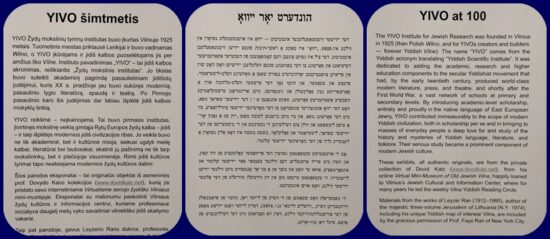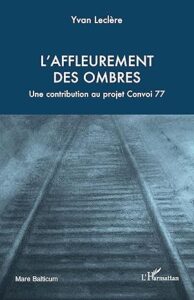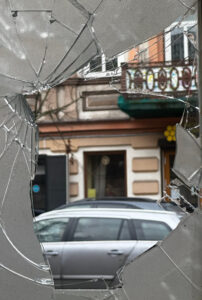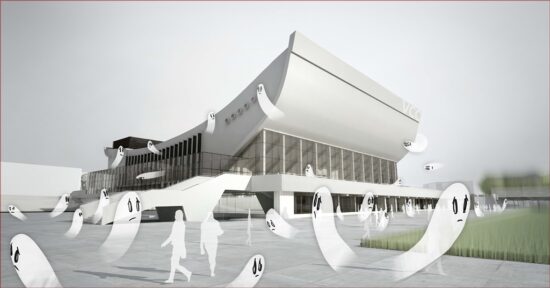[last update]
◊
see also: BOOKS SECTION
[last update]
see also: BOOKS SECTION
◊

Introduction (in Yiddish, Lithuanian, and English) to the exhibit honoring Yivo’s centennial at Vilnius’s Jewish Cultural and Information Center in the heart of the city’s Old Town
It is heartwarming to see the widespread celebration of Yivo’s centenary this year, which is ipso facto a celebration of sophisticated Yiddish language culture in all its many branches. May the year’s events lead to ever more inspiring projects, particularly those that in the spirit of the Vilna Yivo will be carried out in Yiddish, strengthening living Yiddish as a vibrant means of communication, including the higher registers of scholarship and literature, for the generations to come, in accordance with Yivo’s raison d’etre. Although a researcher and teacher with a lifelong affiliation with Yivo and all that it means, I fully, to be honest, expected — as a critic of the present Yivo leadership’s participation in Holocaust obfuscation projects by a certain powerful establishment in Lithuania — to be excluded (not informed, not invited to submit a paper topic) by the recent Yivo conference in Vilnius and its eminent local partners.
◊
◊
◊
 On July 1944, Convoy 77 left the internment camp of Drancy in France, three weeks before the liberation of Paris. The destination was Auschwitz-Birkenau. Eight Litvaks living in France were deported, of whom only one survived the war. The association of the deportees of Convoy 77 would receive the sponsorship of the French Presidency which commissioned schools in France and abroad to research and reconstruct their lives in France and their last days. The project was to “put adolescents in charge not of a sepulchral memory but of the reconstitution of life paths more than death paths.”
On July 1944, Convoy 77 left the internment camp of Drancy in France, three weeks before the liberation of Paris. The destination was Auschwitz-Birkenau. Eight Litvaks living in France were deported, of whom only one survived the war. The association of the deportees of Convoy 77 would receive the sponsorship of the French Presidency which commissioned schools in France and abroad to research and reconstruct their lives in France and their last days. The project was to “put adolescents in charge not of a sepulchral memory but of the reconstitution of life paths more than death paths.”
The project was initiated by a class at the French Lyceum in Vilnius before the Covid-19 epidemic, under the direction of Professor Yvan Leclère, author of a book, Soviet Hegemony. These enthusiastic students began a search on the internet spanning several continents, lasting several years, to piece together why and how these eight Lithuanian Jews had gone to France, how they had lived there and how they came to become ensnared by the Nazis, and finally, sent to their death in Auschwitz. This book can be read as a journal — at times a thriller — that details, sometimes on a daily basis, what progress had been reached in discovering the whereabouts of the eight Lithuanian Jews and also of members of their families who had escaped capture by the Nazis or had been living abroad — and out of danger — at the time these eight were caught.
◊

“View from Vilnius’s Jewish restaurant”
◊
VILNIUS—The following is a transcript (in English translation) of an excerpt from the October 15, 2025 interview with Lithuania’s Minister of Foreign Affairs Kęstutis Budrys (Social Democratic Party) on one of the most popular Lithuanian news sites, 15min, that appeared under the title “Kęstutis Budrys’ Interview with 15min: on Libel against Tsikhanouskaya and the Stain of Antisemitism.”
The incident under discussion this time was yet another antisemitic Facebook post by Remigijus Žemaitaitis, leader of the populist Nemuno Aušra (‘Nemunas’ Dawn’) party, currently one of the three parties in the ruling coalition, together with the Social Democrats (LSDP) and the Union of Peasants and Greens (LVŽS). It is the first time since independence and the rise of Lithuanian democracy in 1990/1991 that an overtly antisemitic party has been accepted into the governing coalition. See Defending History’s monitoring of aspects of the affair. In the most recent outrage, the party leader attacks a major beloved Lithuanian intellectual (a former culture minister and current director of the Lithuanian Museum of Art) by fabricating for him a supposed Jewish heritage.
But Minister of Foreign Affairs Budrys goes far beyond dealing with the issue in isolation.

Dear Readers
Lithuania’s Prime Minister has just announced full reversion to the convention center project in the heart of the Old Vilna Jewish Cemetery that would prove so damaging and tragic for Lithuania’s standing in the world. The many thousands of Vilna citizens buried there have no local descendants to defend their graves because of the Holocaust. Moreover, the unique hand of East European antisemitism is in play (and an antisemitic party lamentably forms part of the PM’s coalition). The simple tests: (a) all other hated Soviet monstrosities are (rightfully!) dismantled; and (b) this would never happen to a five hundred year old city center cemetery of the ethnic/religious majority in the country. Both EU and US congressional law clearly designate the sacrosanct rights of minority cemeteries internationally.
[last update]
BACKGROUND:
OLD VILNA JEWISH CEMETERY AT PIRAMÓNT
EARLIER OPPOSITION TO CONVENTION CENTER |
2023-2024 “WORKING GROUP” ON VILNA CEMETERY
LIST OF MEMBERS WHOSE MORAL CAPITULATION (ALL BUT THE NOBLE PROFESSOR SID LEIMAN) WILL FOREVER BE IN THE HISTORY
MOUNTING OPPOSITION TO THE NEW MUSEUM/MEMORIAL PROJECT
CEMETERIES & MASS GRAVES
HUMAN RIGHTS (INCLUDING THE RIGHT OF THE DECEASED TO BE LEFT IN PEACE IN BURIAL GROUNDS PURCHASED IN PERPETUITY)
CHRISTIAN-JEWISH RELATIONS
See Note below
The professor. Official announcement on website of the Seimas. Article citing former foreign minister. Article explaining that a new Seimas law will mandate spending on far-right history revisionism to smear the historic narrative (the Western narrative, the Holocaust history narrative) as Kremlin-inspired (!) while glorifying the killers of thousands of innocent Jewish neighbors. Far from helping the name of today’s free and democratic Lithuania, this Seimas proposal brings self-inflicted damage of the worst sort — glorifying the perpetrators of the early days and weeks of the Lithuanian Holocaust.
___
OUR TAKE
◊
VILNIUS—There have been two new developments in the saga of Germany’s Forty-Fifth Armoured Brigade, to be established in the forests adjacent to the remains of Europe’s last Jewish partisan fort, where around one hundred escapes from the Vilna Ghetto lived and fought the Nazis and their local collaborators during the Holocaust. See report.
The 20 June updates:
VILNIUS—The following is an edited and updated version of Dovid Katz’s post on Facebook today in reaction to the statement posted today by the Vilnius Jewish Community (VJC) on its website and on Facebook. An English translation of the statement appears in Defending History.
[Updates: See also the media report in Alfa.lt; the statement posted by Jewish Heritage Lita (JHL) on its website; Defending History’s newly compiled section, Lithuania: a Textbook Case of East European Restitution for Lost Jewish Assets Abused to Dismantle and Diminish a Vibrant Jewish Community, which includes contributions over the years by Ruta Bloshtein, Alexander Chernov, Pinchos Fridberg, Simon Gurevich, Leon Kaplan, Arkady Kurliandchik, Zecharya Olickij, Josif Parasonis, the late Jacob Pilansky, among others.]
BRAVO to our democratic Vilnius Jewish Community (which represents over 1,600 Jewish people in Vilnius, constituting the majority of today’s small Jewish community in Lithuania) for proudly standing up and speaking out on this week’s monkey elections at the corrupt “Lithuanian Jewish Community” (which is state-sponsored, via “restitution” no less, deriving from the property values of the annihilated prewar religious institutions). Their statement is on Facebook and their website.
In the middle of the 2017 election campaign, when a certain conflict-of-interest passport lawyer saw that her opponent was winning, the rules were changed mid-campaign to disenfranchise the living Jewish people of Lithuania and replace them with kangaroo “associations” comprising entities themselves receiving monies and/or other benefits from the same restitution.
VILNIUS—The following is an English translation of the statement posted today by the Vilnius Jewish Community (VJC) on its website and on Facebook.
Among reports and reactions: in Alfa.lt; the statement posted by Jewish Heritage Lita (JHL); Dovid Katz’s post on n Facebook and in Defending History; Defending History’s newly compiled section, Lithuania: a Textbook Case of East European Restitution for Lost Jewish Assets Abused to Dismantle and Diminish a Vibrant Jewish Community, which includes contributions over the years by Ruta Bloshtein, Alexander Chernov, Pinchos Fridberg, Simon Gurevich, Leon Kaplan, Arkady Kurliandchik, Zecharya Olickij, Josif Parasonis, the late Jacob Pilansky, among others.]
◊
◊
In 2016, Chris Heath read an item in the New York Times about a tunnel that had been discovered “at a Holocaust killing site”. It was referring to Ponar near Vilna (Yiddish Ponár, Polish Ponary, today’s Paneriai outside Vilnius, capital city of Lithuania). It is around ten kilometers (six miles) southwest of Vilnius city center. This caught his attention and he decided to write a book about this heroic feat. The main title is borrowed from two lines that Shmerke Kaczerginski had written in his poem “Shtiler, Shtiler” (Quieter, quieter) that was put to music and sung in the Vilna Ghetto.
Ponar near Vilna (Yiddish Ponár, Polish Ponary, today’s Paneriai outside Vilnius, capital city of Lithuania). It is around ten kilometers (six miles) southwest of Vilnius city center. This caught his attention and he decided to write a book about this heroic feat. The main title is borrowed from two lines that Shmerke Kaczerginski had written in his poem “Shtiler, Shtiler” (Quieter, quieter) that was put to music and sung in the Vilna Ghetto.
Ponar: 100,000 persons killed by bullets from summer 1941 to spring of 1944, about 70% of them Jews including women, children, and the elderly.
Ponar: List of twelve escapees from Ponar who survived (April 1944): Josef Bielic, Abraham Blazer, Yitzhak Dogin, Yuli Farber, Shlomo Gol, David Kantorovich, Zalman Matzkin, Lejzer Owsiejczyk, Konstantin Potanin, Motke Zeidel, Adam Zinger, Peter Zinin

Rašella Galinienė, elected head of the Jewish Community of Shavl (Šiauliai) speaks out to protest insensitive desecration of a Holocaust mass grave site where Jews of Yánishok (Joniškis) were massacred. Photo: Shavl Jewish Community.
Rašella Galinienė, elected head of the Jewish Community of Shavl (Šiauliai, northern Lithuania) has led a public call for removal of a series of sculptures erected by a nearby local government authority directly atop the actual graves, in the forest, of hundreds of murdered Jews of the shtetl Yánishok (or Yáneshik, today’s Joniškis). The issue has been reported on prominently in Lithuanian media, including on LRT TV, and the LRT news portal (where mechanical translation to English captures nearly all the text accurately). The media reports dwell on issues of permits, permissions, consultations and the difference of opinion between the Shavl community and the local authorities in the district where the forest mass grave is situated. They report accurately, that the late and long standing beloved leader of the Shavl community, Sania Kerbl (Kerbelis, 1963–2024) expressed — in concord with Jewish tradition and law of thousands of years standing — his staunch opposition to anything being constructed or erected on cemeteries and burial sites.
VILNIUS—International media has reported in detail on last week’s military ceremonies in Vilnius celebrating the permanent installation of thousands of German soldiers as part of NATO forces in Lithuania, southernmost of the three Baltic republics. The new entity is “Germany’s 45th Armoured Brigade” (Panzerbrigade 45) that is also known as the “Lithuania Brigade”.
The Defending History community is a staunch supporter of the values and security needs of the European Union, NATO, the Western alliance of free and democratic nations, and has from day one condemned the medieval, barbaric February 2022 invasion and unleashing of mass death and destruction upon Ukraine by Putin’s Russian Federation forces. Our support includes reproducing a statement that has appeared for over a decade on p. 1 of DefendingHistory.com (right hand column). As stated there, adherence to the democratic values of the EU and the NATO alliance includes cherishing the free-speech right to criticize: efforts to rewrite Holocaust history by Eastern Europe’s ultranationalist far right; efforts to defame the victims, including Jewish partisans who fought valiantly against the Nazis; efforts to disseminate Double Genocide revisionism in the realm of Holocaust and World War II history; efforts to glorify Holocaust collaborators and perpetrators; efforts to curtail free speech by criminalizing or delegitimizing views that oppose these efforts.